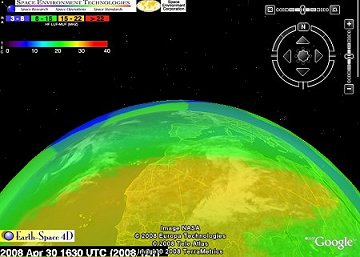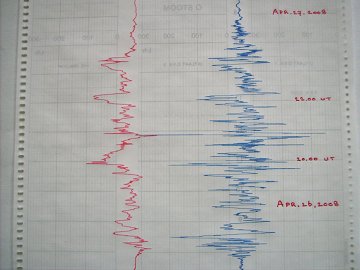| MOTHER'S DAY: Give your mom a truly heavenly gift on May 11th--a subscription to Space Weather PHONE! | | | MUST-SEE FILAMENT: A dark magnetic filament is snaking over the sun's western limb today, producing a beautiful 3D scene for amateur astronomers to photograph. "It's spectacular," says Robert Arnold who sends this picture from the Isle of Sky, Scotland. If you have a solar telescope, take a look! more images: from C. Keller and J. Stetson of South Portland, Maine; from Pete Lawrence of Selsey, West Sussex, UK; from Didier Favre of Brétigny sur Orge, France; 4D IONOSPHERE: The ionosphere is our planet's "final frontier." Stretching from 50 to 500 miles above Earth's surface, it is the last wisp of Earth's atmosphere that astronauts leave behind when they enter space. It is a realm of dancing auroras, radio-bending plasma bubbles and dangerous ultraviolet rays. And it is now on your home computer! (continued below) 
Above: A screenshot of the 4D ionosphere
Yesterday, NASA-supported researchers at the Space Weather Workshop in Boulder, Colorado, unveiled a "4D" computer model for the general public. Download a few files and presto--you're flying through the ionosphere. The model shows the ionosphere as it is right now; it's a real-time display based on current solar activity and atmospheric conditions. This new tool can help ham radio operators plan their next DX transmissions, help pilots avoid polar radio blackouts, and help researchers see the effects of solar flares on Earth's atmosphere--and it's fun, too. Find out how to start your own flight from Science@NASA. GEOMAGNETIC STORM: "Where we live in Norway at 68o N latitude, the sky is too bright for auroras," reports Rob Stammes. At this time of year, the midnight sun spoils the show. "But I have another way of seeing the Northern Lights--on the paper of my magnetograph." 
The squiggles on this plot, recorded by Stammes at the Polar Light Center in Lofoten, Norway, trace a geomagnetic storm on April 26th and 27th. "Red," he explains, "is the local magnetic field" swinging back and forth as a solar wind stream buffets Earth's magnetosphere. "Blue denotes electrical currents" flowing through the ground outside the instrument room, induced by the swinging motion of the overlying magnetic field. Gusting solar wind, swinging magnetic fields, surging ground currents: that in a nutshell is a geomagnetic storm. If only the sky had been a little darker. April 2008 Aurora Gallery
[Aurora Alerts] [Night-sky Cameras] | 
